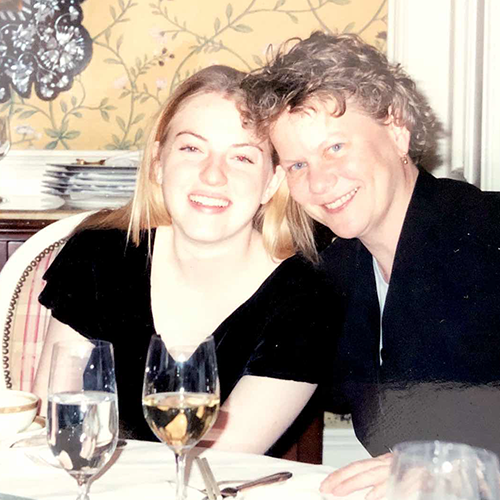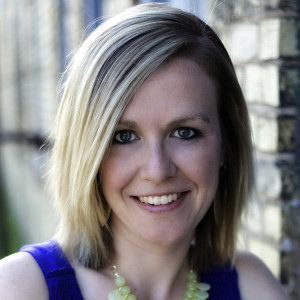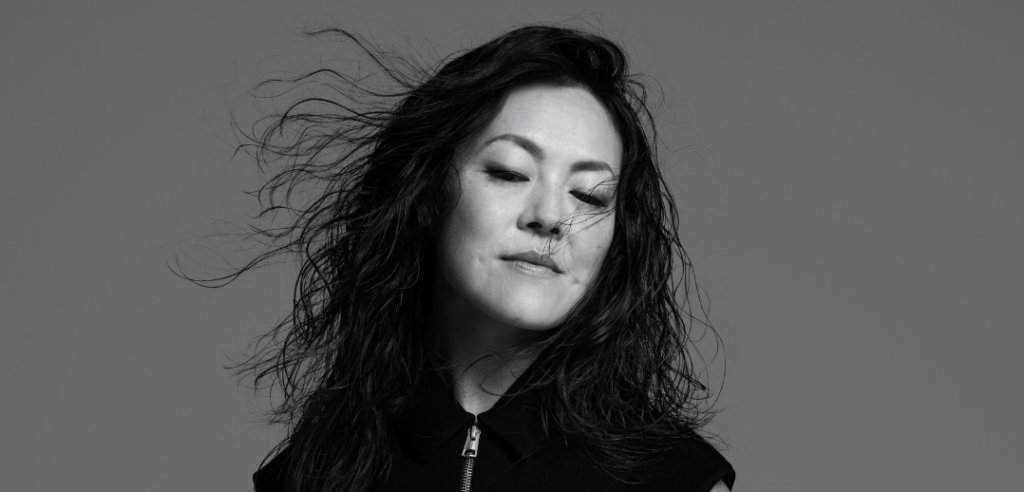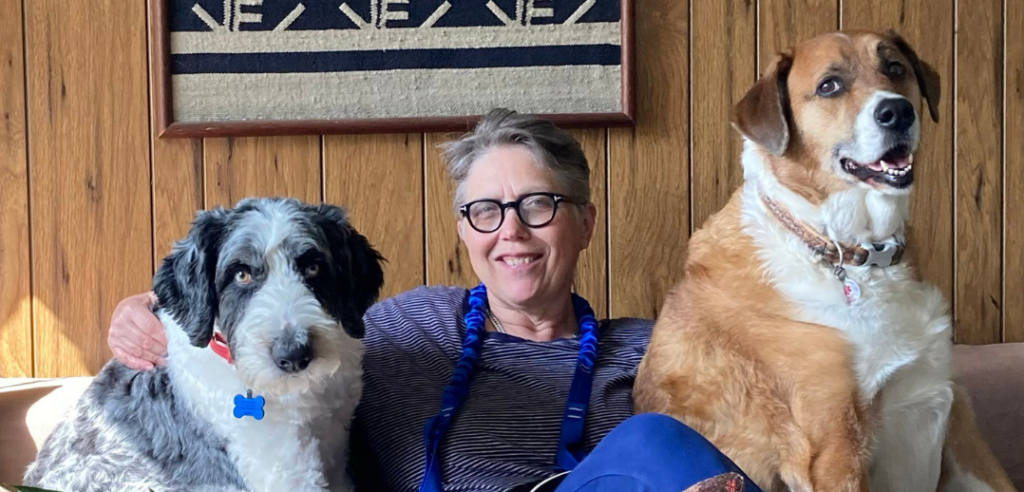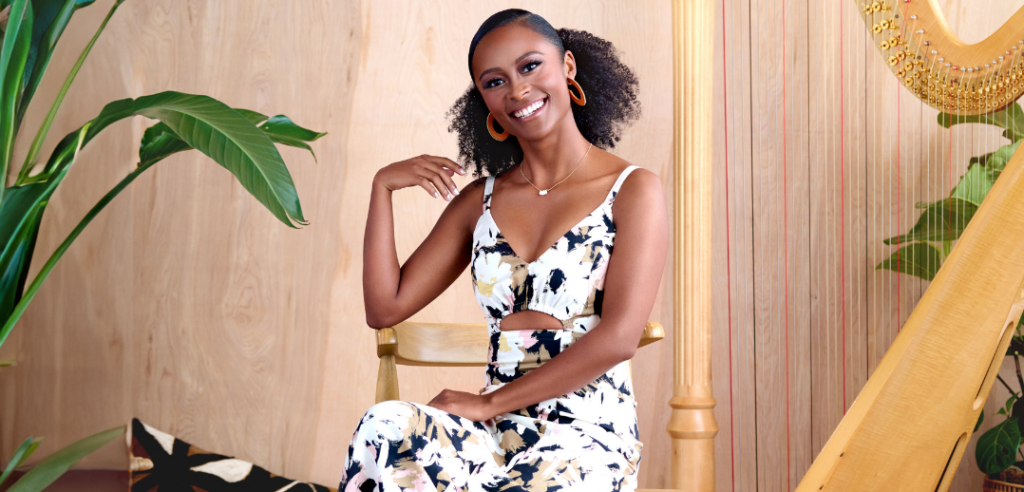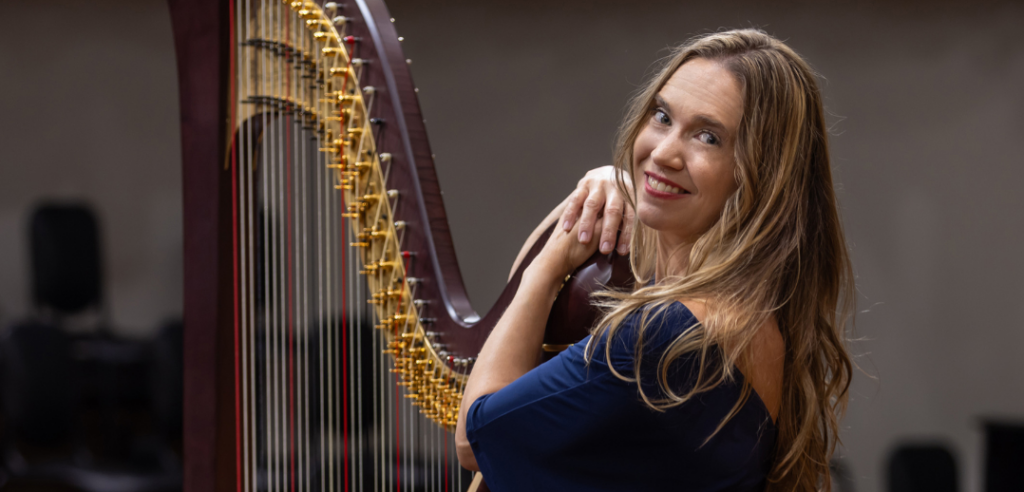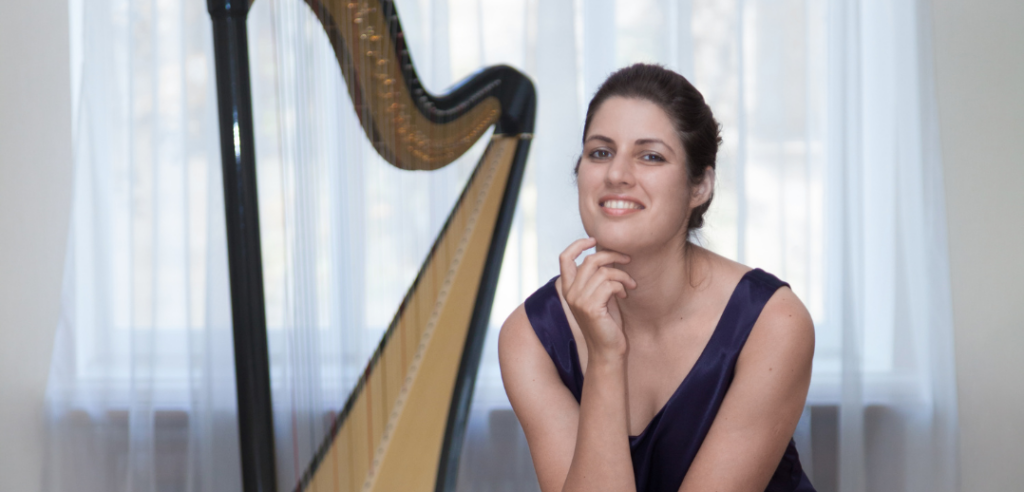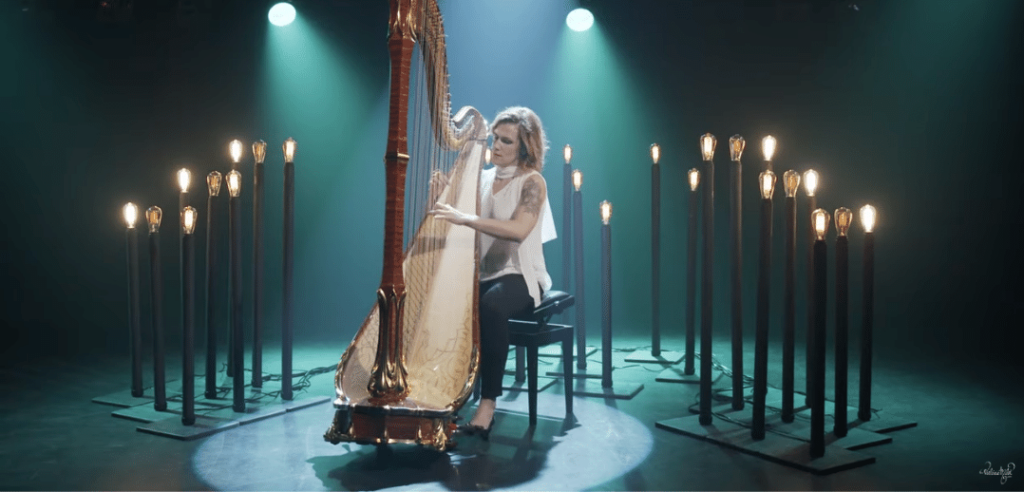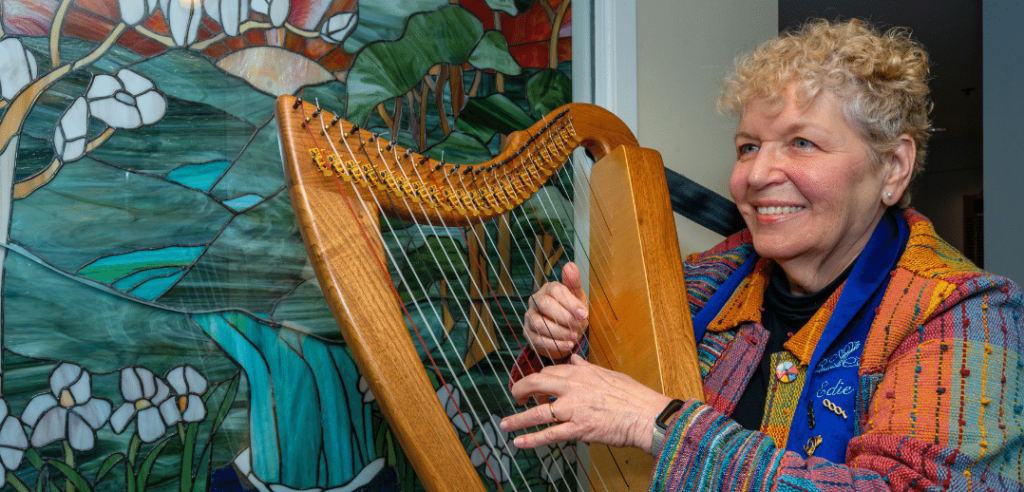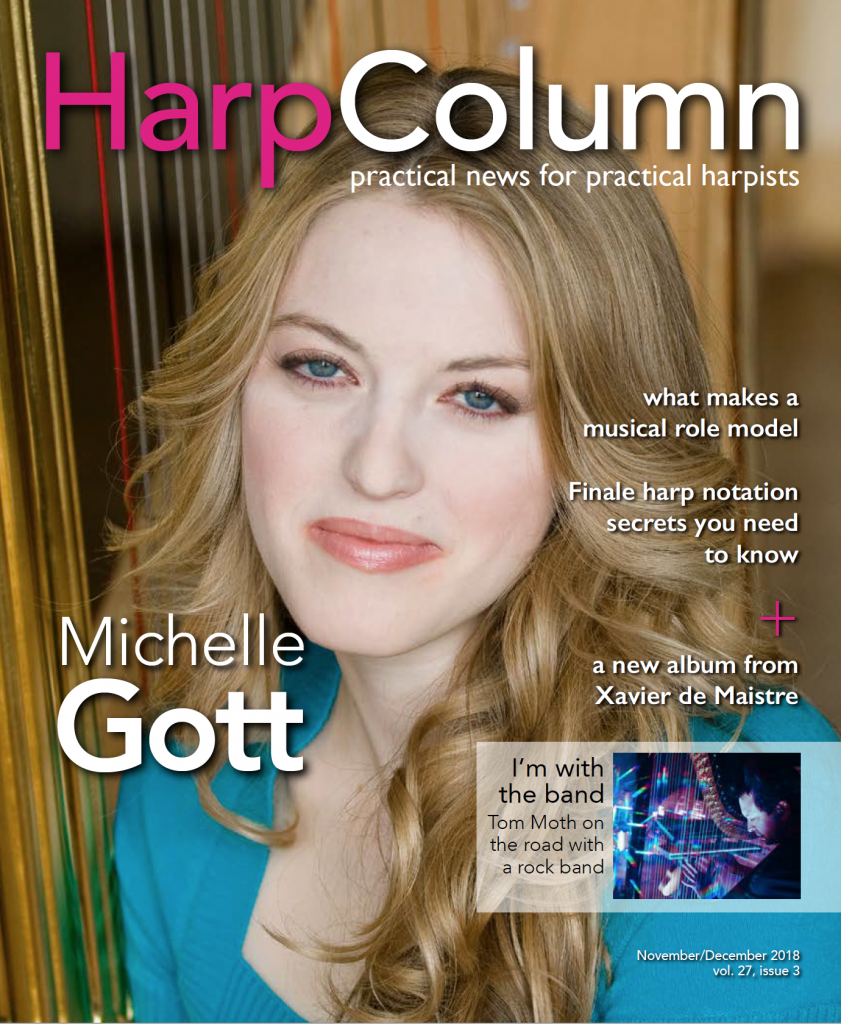When the University of Arizona announced last summer that 33-year-old Michelle Gott would be its new harp professor, it marked a generational shift in the harp world. The tragic death of long-time legendary harp professor Carrol McLaughlin last spring left a gaping hole at one of the country’s most notable university harp programs. Now, a program led for more than 30 years by McLaughlin, a Baby Boomer, will be headed up by a Millennial.
We caught up with Gott via Skype earlier this fall to talk about her new appointment at Arizona and all of the hard work that lead to this moment.
Harp Column: You are about a month into your first semester teaching at Arizona. How’s it going so far? What are your first impressions?
Michelle Gott: I love the students. They are so wonderful. They’re also really well trained—Dr. McLaughlin, Carrol, she really ran a tight ship. Even through her illness, you see these students really understand how to practice, how to show up for masterclass and lessons. There was a dress code in place before I came in. They are professional and on top of things and very curious. I think the last couple years were hard for them because there was a lot of uncertainty. Carrol was such a bright figure, and I think there was real belief that she would be back. Now we’re in a phase where there is definitely grief and also a hope for the next chapter and a real need for everything to be in place. That’s where I’m at in terms of re-establishing things—picking up where she left things off and also implementing my own ideas. It’s quite the transition.
Hc: How many harp students are in the program right now?
MG: I work with eight and there are two others that take lessons with my TA [teaching assistant], but all 10 will be working with Harp Fusion, our harp ensemble.
Hc: You’re stepping into some very big shoes, obviously. Carrol was there for over 30 years, and she built an iconic harp program. How do you honor her legacy while also bringing your own talents and interests and ideas into the program?
MG: That’s a really good question. It’s something that’s been on my heart, not just my mind, for months. I was influenced by her, so I have deep respect for who she was and what she brought to the program. But I can’t be Carrol. So while I recognize that I’m filling big shoes, at the same time I’m not really. It’s like I’m filling a different pair of shoes—maybe they have the same fabric or something, but it’s a different pair of shoes. There are ways we can honor her. I’m actually hoping to go to Canada on my first tour with Harp Fusion because she was Canadian, and I’d like to reconnect with where she came from. Also, I’ve had such a connection with Canada myself that it seems to make sense. For me, it’s important to take the incredible aspects about her program—the emphasis on high-level solo performance, the creativity exercised in her fusions, the student ensemble arrangements, the recording and touring—and develop it a little bit more in terms of what I view as being necessary for the students to be well-rounded today. For me, that involves making sure they are trained in many different areas such as orchestral repertoire, getting ready for auditions, chamber music, having a social media presence, and understanding the technological side of things. There are aspects that I’m very strong in that I think were not central in the program before.
…every harpist is going to have a unique career path, and I want to connect with every student and help them to be honest with themselves as to what really makes them come alive.
Hc: There are a number of harpists of your generation—Millennials—such as Heidi Van Hoesen-Gorton, Emily Levin, Allegra Lilly, who have won major orchestral positions in the last few years. But you’re really the first harpist of your generation to be named to a teaching post at one of the country’s well-established harp programs. Arizona is the first big college harp program to see a changing of the guard with your generation now stepping into a major teaching role.
MG: That is something I’m not sure I’ve fully processed yet.
Hc: You could potentially be at Arizona for decades to come, shaping the next few generations of harpists. What kind of harpist do you want to emerge from your program?
MG: The first thing is that every harpist is going to have a unique career path, and I want to connect with every student and help them to be honest with themselves as to what really makes them come alive. That’s part of it. The other part is training students to the highest level that I can in the areas that I think are crucial to be a harpist today. I think it is essential to have all of these different tools in your toolbox. But it does take training and it does take a lot of time and it does take a lot of focus and organization. I want students to know if your training is solid, your knowledge base is broad, and you are committed to your craft in the sense that you are curious and invested and you’re exploring things on your own, then all I have to do is sharpen those skills, give you those tools, and support you.
Hc: Could you talk a little about what you hope to do with Harp Fusion? The University of Arizona is known for this harp ensemble that has always recorded and toured extensively.
MG: Every student that plays harp at U of A participates in Harp Fusion. I think it’s such a dynamic group, and it’s known for doing all its own arrangements. We meet twice a week for two hours, so we have a lot of time together. So far this year, we’ve been working together as an ensemble on exercises that target theoretical concepts and technical challenges as a group. Then there’s time for arranging and workshopping our projects. I started bringing in some multi-harp orchestral repertoire with the ensemble too. So if we’re studying something like Symphonie Fantastique, or Magic Fire Music, or Salome’s Dance, we can bring them into the Harp Fusion setting because we have so many harps. Also, I think in the past they’ve all arranged music that they really liked. You know, someone’s going to do this, someone’s going to do that. I’m working towards a more thematic concept of our project. This won’t work every time, but right now we just completed our project planning for our spring concert which will be centered around modes of transportation. Every piece has something to do with some sort of transportation—a planes, trains, automobiles, and spaceships kind of thing. I’m so excited about it. In February we are doing a dance collaboration. I’m arranging a piece for three harps with three dancers so I’ll be working with choreographer Autumn Eckman on this project. We’re starting out small so it’s a five-minute piece. It’s nice and concise, manageable. Ultimately I am hoping that this, along with some other relationships and collaborations within the school, will lead to a multidimensional project with Harp Fusion where the harps and dance and hopefully theater would be fused. It would be interdisciplinary but with a goal of making every part of that integral to the drama. That’s what I’m hoping for as part of Harp Fusion’s direction. I’d like to modernize Harp Fusion’s image, while still tying back to some of those quintessential elements. I think we’re in a period of honesty and being true to yourself—that is what I’m trying to get my students to connect with. Again, I can’t be Carrol, I’m not Carrol. I can’t lead Harp Fusion in the way that she did because it’s not who I am, but I can honor parts of it and tie back to those things.
HC: You taught at the University of Ottawa before coming to Arizona. You also had a harp ensemble there, right?
MG: Yeah, I did a lot of work with the Ottawa Youth Orchestra Academy. It’s an incredible program. They have beginning classes for young students, so I would teach lessons and ensemble to total beginners. How do you read music? What is a quarter note? The program is very strong now, but when I came in it needed to be rebuilt. My first class was one student who had never done any harp and one student who had many years of experience. Now, the classes are divided into beginner, junior, intermediate, and senior ensembles. They also have two youth orchestras that harpists can be a part of. So it’s healthy and strong and continuing to grow, which is great. The students are so wonderful, and so are their parents.
HC: Your passion for teaching is obvious to anyone watching you teach or hearing you talk about your students. Where do you think that came from? When did you know you wanted to teach?
MG: I think it comes from different sources. My mom was a harpist and my teacher basically until I went to Juilliard. I had a couple of summer programs in between. I had a very pivotal summer at Interlochen with Lynne Aspnes. Then a very pivotal summer at Aspen, which at that time was split between Gretchen Van Hoesen and Nancy [Allen]. Those were really big experiences. I’ve also had incredible influences from my different piano teachers when I was younger, most importantly, Elissa Stutz Lechnir. I find myself pulling from her techniques, her teaching technique, her philosophy. I had a wonderful theater director Dane Madsen, and a wonderful choir teacher in high school, Kimberly Barclay Ritzer. I had so many good teachers at the high school I attended—Green Valley High School in Henderson, Nev. I’m talking about these people because, as I was learning from them, I was really inspired by the way they worked with me. You start wondering, “Could I have that kind of influence? Could I make a difference like that through teaching?” I think when you first start out—for example when I got to Ottawa and was approached about taking on the youth orchestra academy position, I thought, “What?! I don’t know how to do this.” It had been a long time since I had taught a beginning harp lesson. I panicked a little, but then I realized, “Okay, you can figure this out. This is going to be fun.” I had to dig back and try to remember how you would even come to this instrument. That was a hard question for me because it was in my house. How did I come to it? I don’t know. I was a baby banging on the bass strings while my mom was practicing. I really had to think about why would someone even be curious about this instrument? What would speak to a really young kid? You start by that and slowly, inch-by-inch figure out what to introduce next. What works best and how do you phrase it for a beginning six year old versus a beginning 50-year-old?
So I would say the influences I had from teachers across the board—not just harp, but in many different areas—combined with questions I’ve had to face about how to teach from the first minute of your very first lesson with somebody up to advanced levels have encouraged me to reflect a lot on my own self. What do I value? How do I want to communicate this to somebody? I enjoy those challenges. I enjoy thinking about that. I think the third component comes from experiences, lessons, or an approach to an organization structure that I, at various times, have been lacking and have wanted more from various educational situations. I found myself frustrated at times and analyzing, “Why am I frustrated and how would I fix this?”
HC: You mentioned your mother—she was an amazing harpist and your first teacher. How does she continue to influence your life and your music and your teaching?
MG: She’s been gone almost 10 years. It’s difficult because there are questions that I have now that I didn’t have back then. So much has happened for me in that time. I think there are specific questions about teaching and about all this stuff that I didn’t ask, but I wish that I had. I have a huge library of her music with lots of annotations. I also have my mom’s instruments. That has been an invaluable resource for me. I’ve been able to lend them to the students for practice and used them in ensemble, especially in Ottawa. I’ve also been reflecting on the joy that a lot my mom’s students had when they worked with her. I like to have that same kind of connection with my students and know that they are getting what they need in lessons. That’s not always just technical or musical advice. I think my mom was really good at that with her students.
HC: What do you think she would have said if she could see you now at Arizona? What do you think she would say?
MG: I feel like she would be really, really proud. I think she would view it as I do, as an amazing culmination of so many things that have happened. It’s not just my training and professional experiences, but I think there have been a lot of personal experiences that have kind of cracked me open to a possibility like this. I think she would very much say this. I think she sees it. Honestly, even the process of losing her and having to deal with death myself gives me a really different perspective on what my own students are dealing with. It doesn’t have to be your mother who dies for you to go through all those stages of grief. Because I dealt with it and I’ve had nine years to reflect on it, I can talk about death because I get it. Sometimes there are no words, and you don’t talk about it, but I can sit there with somebody and let them feel what that is. Before that kind of an experience, you can’t translate that pain, that loss, or even the anger that sometimes comes along with it. It’s not that I would plan this out the same way again to learn these lessons or be able to deal with these kinds of things. That fact is that my mom passed away. It was one of the most difficult times of my life, and I had to find a lot within myself. She influences me because of those experiences.
HC: You grew up in Las Vegas. Not many people grow up in Las Vegas. It’s just not that common to be a native, right?
MG: Not for a classical harpist. [Laughs]
HC: Maybe in another line of work, but not in your line of work. [Laughs] Then you were in New York for all of your college years, right?
MG: Yes, I was in New York full time for eight years then transitioning to Canada for two more years as I finished my doctorate. I officially became a resident of Canada in 2013.
HC: Then you were in Ottawa for five or six years?
MG: Officially five years and something, yes.
HC: And now you’re in Arizona—you’ve been all over the place. What feels like home for you right now?
MG: That’s such a good question. I haven’t had enough time in Tucson to feel like that’s home yet. Actually, even the desert doesn’t feel like home anymore because New York has trees, and Ottawa has trees. I would say Ottawa feels like home right now because it’s the closest to me at the moment. I had a lot of formative experiences there. New York feels like second home. Once you learn how to live in New York then it’s sort of always part of you—like riding a bike. Then I guess Vegas feels like third home. It’s sort of like an expansion of home. They all feel comfortable and fluid in different situations.
HC: You’ve gone from one climate extreme to another. Freezing cold to the desert heat. How are you feeling about that transition?
MG: I panicked a little bit. It was so hot I felt like, “I can’t breath. I actually can’t breath here.” And it’s dusty. But Arizona gets some incredible sunsets. I have never seen more saguaros in my life. There are lots of hiking trails. You can go up to the mountains—Mt. Lemon. It’s a good 25–30 degrees Fahrenheit cooler up there. This is good. I like these things. But what feels like home? I’m still figuring that out. Home is that feeling you create, that’s what I hear, so I’m still working on that.
HC: What do you like to do when you’re not at the harp?
MG: Once I got out of my doctoral program, I needed about two years of non-serious reading. I was so tired of reading. Now I’m back into reading more. It’s good. And I love spending time with my dogs. I have two dogs—a lab mix and a husky mix. The husky mix has some interesting coloration—I’ve been asked if she’s a coyote in Arizona. I don’t know, maybe? It’s kind of funny. I also love exploring different types of cuisine, which has been really interesting in Tucson. It’s quite a food city.
HC: Well, it sounds like you are in a great place.
MG: My path has slowly evolved. There have been a lot of times when I wondered, “Is this going to lead to anything? Am I going to feel valued for the work that I do?” I will always work hard at what I do, no matter what. It’s just something within me, I think. It means a lot to me to work, but if you don’t see results immediately, or at least not on the level you’re trying to achieve, it can be discouraging. But it’s really important to work through the dark periods—stay on the path, do the work, and believe in what you bring. Sometimes Nancy [Allen] had these amazing pithy comments in lessons. She would say stuff like, “Play beautifully.” Or, “Do the work.” They’re tiny little comments, but they’re so right. Do the work. Play beautifully. Play music because it’s beautiful and because it’s part of you. It takes a lot of faith and trust. I think we live in an age of possibilities, but having more options can be scary and also incredibly rewarding because it means that your life can be very customized. It can be more true to who you are, not necessarily inside the constraints of traditional routes. I would say to anyone—not just students but anyone who is dealing with trying to figure out the next step—just do the work, play beautifully, and keep going.
HC: Well said. •










